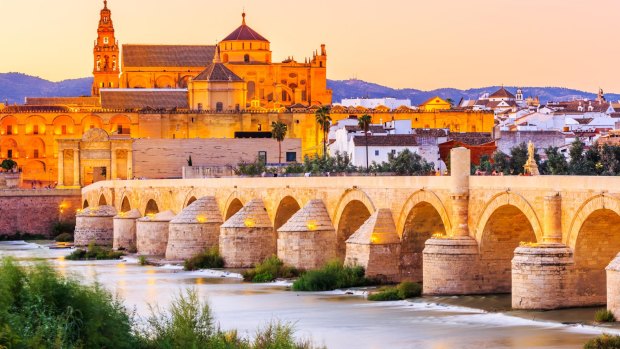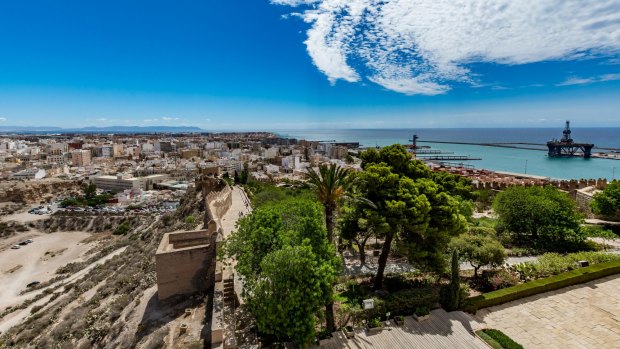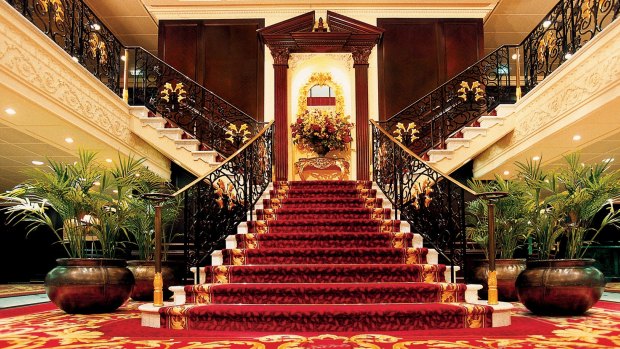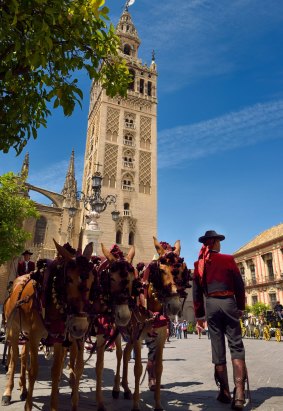This was published 5 years ago
Oceania Insignia: Rome to Lisbon on an ocean turned river cruise
While the tide is turning against megaship visits to Europe's big cities, smaller ships are a good alternative to see Europe's smaller charms.

The Guadalquivir River, Cordoba, Spain.Credit: Alamy
Six days into our journey from Rome to Lisbon on board Oceania Insignia we wake up at dawn to find the ocean cruise has turned into a river cruise. We are sailing up Spain's Guadalquivir River towards Seville, the country's only inland port, and the change of scenery is dramatic.
The rugged Atlantic coastline has given way to misty expanses of fields and wetlands stretching as far as the eye can see. We pass a few shabby fishing boats trawling black nets and it is more like sailing on the Mekong than being in the heart of Europe. A fellow passenger taking in the views tells us that the river forms the southern border of the Donana National Park, a vast reserve for migratory birds and home to the rare Iberian lynx.
Further upriver we sail through a lock on the outskirts of the city and as we reach the port it becomes clear why only small vessels can navigate the Guadalquivir. Insignia squeezes through the opening road bridge Puente de las Delicias with just centimetres to spare – everyone is on deck to photograph the feat – then it slips into its docking spot alongside a cool-looking cruise terminal built from shipping containers.

The walls of Alcazaba, Almeria, Spain.Credit: Alamy
We walk towards the old city along broad, tree-lined boulevards and narrow streets intersecting with glorious plazas and marvel not just at the beauty of it all but the light and heat – it's only May and the sun is intense. Horse-drawn carriages, bicycles and trams pass by at a leisurely pace and we wander into the massive cathedral for a pre-lunch culture hit.
The brochure I pick up says it is the largest Gothic cathedral in the world, although St Peter's Basilica in the Vatican also makes the same claim. Regardless of whether it's No. 1 or No. 2 in the Biggest Cathedral stakes, Christopher Columbus is definitely buried there – that was proved after DNA tests resolved a long-time controversy that the remains brought to the cathedral from Cuba in 1898 were actually his son's. Columbus' tomb, like the rest of the cathedral, is incredibly lavish and ornate.
After a late lunch in a tiny back-street bookshop-cafe we meet our e-bike tour guide for a spin around some of Seville's most significant landmarks. Marie explains the history of the cathedral's famous Giralda bell tower; Giralda was built as a minaret in the 12th century, when Andalucia was ruled by the Moors and the cathedral was a grand mosque.
Seville's rich Moorish heritage is evident everywhere you look.
Seville's rich Moorish heritage is evident everywhere you look – the nearby Royal Alcazar Palace complex being the most spectacular. Still the official residence of the Spanish royal family, it has starred in various films and most recently in Game of Thrones.
We stop to look around a more recent historic monument, the imposing 18th-century tobacco factory that is now the University of Seville. Marie weaves fascinating stories of trade, politics and power-grabs from every era into her narration – and also assures us that the horses pulling the tourist carriages around the city are owned by the local government, have a field near their stables and are regularly checked by vets. No wonder they look healthy.
Moving into the 20th century, we glide through the lovely Maria Luisa Park to the Plaza de Espana, an imposing semicircular building of various architectural styles that was built for the 1929 Ibero-American Expo. Its sweeping tiled "square" is the size of five football fields and the Moorish-Spanish-Renaissance edifice features ornamental balconies, bridges, a canal and two towers that you can see from the ship's deck.

The atrium, Oceania Insignia.
Seville staged another expo in 1992 and the soaring Alamillo bridge is one of five that were constructed for the event. The expo opened up the Isla de la Cartuja, which is now a science and education park – our bike ride doesn't go there but we do ride past the Guatemala pavilion, the smallest of the 1929 expo constructions, and unkindly referred to as "the loo" by locals.
Seville is definitely the high point of the Spanish ports we visit on this cruise and next time an evening of flamenco at Casa de la Guitarra will be on my "must do" list – it comes highly recommended by Insignia's Spanish executive concierge, Juan Carlos Cortes.
Barcelona needs no introduction to the millions of tourists who throng the city every year – until numbers are curbed, anyway – but Alicante and Almeria, smaller towns on our itinerary that we visit before Seville, have much going for them. Their streets and plazas are pleasantly uncrowded, although even in early summer Alicante's main beach is crammed with sun-worshippers lying in regimented rows of sun-loungers. But we're not here for the beaches.

La Giralda bell tower, Seville Cathedral, Spain.Credit: Alamy
The wavy, tiled waterfront esplanade is Alicante's best-known landmark and towering above the city is the Castle of Santa Barbara. You can walk, drive or take a lift to the top, for stunning views of the coast and to explore the three distinct levels of the medieval fortress.
After wandering slowly back through the park and into the old town we spend a couple of hours in the contemporary art museum, MACA. It's almost hidden away, in a beautiful baroque building next to the Santa Maria basilica; works by world-renowned Spanish artists Picasso, Dali and Miro are on display, along with some extraordinary kinetic and geometric pieces by Eusebio Sempere, a name not so well known internationally but acclaimed in Spain.
In Almeria, we find ourselves in the midst of a saint's day fiesta in the cathedral plaza. Many of the women are clad in traditional colourful flamenco dresses, flowers tucked behind their ears and flicking fans; men are wearing flat broad-brimmed hats and stylised riding suits; there are priests, pipers, drummers, and a procession leading a highly decorated silver shrine.
We discover later that it's part of an annual pilgrimage to the shrine of the Virgen Del Rocio (Virgin of the Dew).
Fairs (feria) and fiestas are held all over Spain and in Andalucia alone there are more than 3000 a year. We see an unusual symbol on walls and in shop windows all over Almeria, an Indalo, which is a ghost holding a rainbow in his hands – many local people wear them as a lucky charm.
Like Alicante, Almeria has a medieval fortress, the mighty Alcazaba; it looks impressive from below but we decide one castle a week is enough and head back to the ship for an afternoon's R&R.
Many of the passengers are on a world cruise. Among the things these seasoned cruisers love about Insignia are its size (it carries no more than 684 passengers), its sense of camaraderie, its crew – and its culinary offerings. By the time we reach Lisbon – another story altogether – I am in complete agreement with the "worlders".
TRIP NOTES
MORE
FLY
Emirates operates three flights daily from Sydney and Melbourne to Dubai, with three daily connecting flights from Dubai to Rome. Phone 1300 303 77, see www.emirates.com/au/english/
CRUISE
Five of Oceania Cruises' ships cruise in the Mediterranean between April and November 2018 and 2019. Sirena sails a 10-day Lisbon to Rome itinerary on July 5, 2019. Fares start from $4040, including an O Life choice of unlimited internet plus house drinks package or $600 shipboard credit or six free shore excursions. Phone 1300 355 200, see www.oceaniacruises.com
Sally Macmillan travelled as a guest of Oceania Cruises and Emirates.
FIVE THINGS TO KNOW ABOUT OCEANIA CRUISES
THE FLEET
Oceania operates four nearly identical 684-passenger ships (Regatta, Insignia, Nautica and Sirena) and two 1250-passenger ships (Marina and Riviera). All were lavishly refurbished in 2014 and Sirena, the line's latest acquisition, had a makeover in 2016.
R-CLASS
The four smaller ships in the fleet belong to the resilient R-class, eight of which were built between 1998 and 2001 for the now defunct Renaissance Cruises. The other four R-class ships now belong to Azamara, Princess and P&O UK.
BIG SISTERS
Marina and Riviera were purpose-built in 2011 and 2012. A standout feature on board both is the Culinary Centre, one of the first hands-on cooking schools at sea. Each ship has 10 dining venues, including five specialty restaurants; only two attract an extra charge.
FITNESS
Foodie cruisers now have no excuse for not hitting the gym to work off those deliciously acquired calories – many of Oceania's fitness classes are now complimentary. Just make sure you actually sign up for anything from stretch and yoga to full body strength training and core conditioning sessions.
CRUISING GROUNDS
Where don't the ships sail? Insignia is doing a world cruise in 2019; Nautica will be in Africa this year; and Regatta is sailing in Australia and New Zealand during the 2018-19 season. Alaska, Scandinavia, the Mediterranean, Caribbean, Cuba, South America, Canada and New England are all on Oceania's itineraries.
Sign up for the Traveller Deals newsletter
Get exclusive travel deals delivered straight to your inbox. Sign up now.